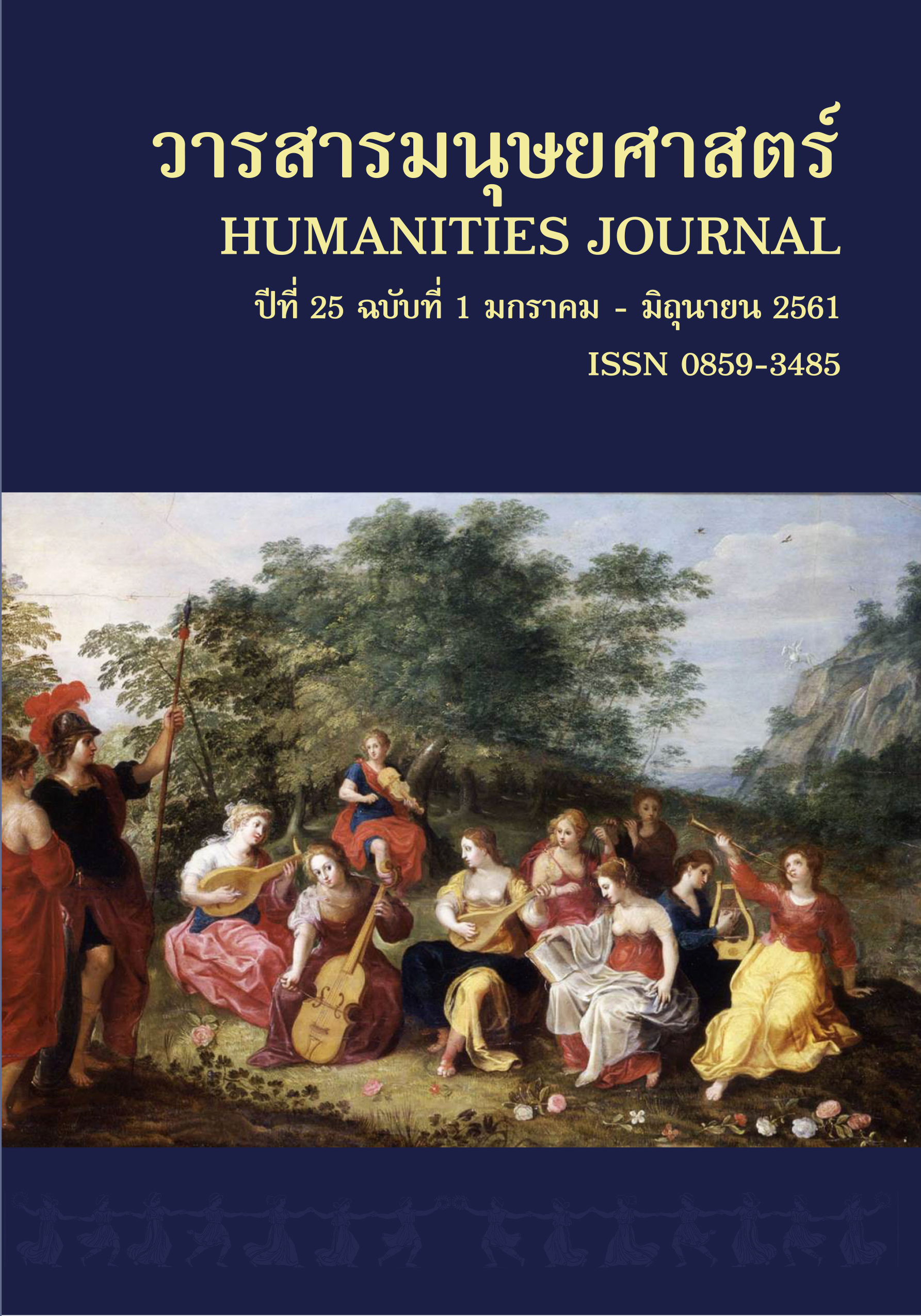ฟังความสองข้าง:ความสำคัญและนัยยะของผู้เล่าเรื่องแบบบุรุษที่หนึ่งในนวนิยายเรื่อง มายาเงา
Main Article Content
Abstract
บทความนี้มุ่งศึกษากลวิธีการใช้ผู้เล่าเรื่องแบบบุรุษที่หนึ่งในนวนิยายแนวลึกลับเรื่อง มายาเงา ของพงศกรเพื่อแสดงให้เห็นความสำคัญและนัยยะของกลวิธีดังกล่าวต่อการนำเสนอเรื่อง ผลการศึกษาพบว่า มายาเงามุ่งเสนอสารเกี่ยวกับความรุนแรงต่อเด็ก โดยใช้กลวิธีการเล่าเรื่องแบบบุรุษที่หนึ่งซึ่งมีผู้เล่าเรื่องสองฝ่ายและสลับการเล่าระหว่างตัวละครเอกสองตัวไปมาอย่างคงที่ ก่อนจบเรื่องด้วยการใช้ตัวละครรองในฐานะพยานเป็นผู้สรุป กลวิธีลักษณะนี้มีส่วนสำคัญยิ่งต่อการสะท้อนภาพตัวละครเอกผู้ป่วยเป็นโรคบุคลิกแปลกแยก เขาจะหลงลืมอีกบุคลิกหนึ่งอย่างสิ้นเชิงเมื่อเกิดการบีบคั้นอารมณ์และอธิบายเหตุการณ์ร้ายแรงที่เกิดขึ้นต่างๆ ว่าเป็นการกระทำของวิญญาณ ขณะที่ผู้เล่าเรื่องอีกฝ่ายเป็นผู้ถ่ายทอดความจริงอีกด้านหนึ่ง เพื่อถ่ายทอดถึงความผิดปกติทางจิตของเขาอันส่งผลร้ายต่อผู้อื่น แต่ก็ยังแสดงความเห็นใจและให้อภัยเขาอยู่ในที นอกจากนี้ การปะทะระหว่างความเชื่อเรื่องวิญญาณและคำอธิบายทางการแพทย์ยังได้รับการนำเสนอผ่านการใช้ผู้เล่าเรื่องแบบบุรุษที่หนึ่งเช่นนี้ด้วย พร้อมกับสะท้อนนัยยะเรื่องการเข้าถึงความจริงว่า แต่ละผู้เล่าเรื่องต่างอยู่บนจุดยืนและผลประโยชน์บางประการ การที่ผู้อ่านจะเลือกเชื่อความคิดชุดใดนั้น ผู้เล่าเรื่องนับเป็นปัจจัยหลักต่อการสร้างความชอบธรรมให้แก่คำอธิบายชุดนั้นๆ โดยผู้เล่าเรื่องแบบบุรุษที่หนึ่งเป็นส่วนแสดงให้เห็นการเมืองของผู้เล่าแต่ละฝ่ายได้ชัดเจน ควบคู่กับสะท้อนให้เห็นว่าความจริงจะเป็นเช่นใดก็อยู่ที่ผู้ใดเป็นผู้เล่าเรื่อง
This article aims at exploring I-narrator technique in Maya-Ngao [The Illusive Shadow], a Thai thriller novel written by Pongsakorn, to illustrate its significance and implication of the novel’s presentation. The result depicts that the novel intends to share messages associated with child abuse by constantly using a more-than-one-I-narrator to narrate the common story. It means that two main characters invert their own perspectives in occurring events before a witness character is selected to summarize the ending in the final chapter. To highlight this technique, a more-than-one-I-narrator method not only encourages readers to recognize the story in two dimensions but also reflects the main character who suffers from the multiple personality disorder. This character is found losing his memories when confronting intense situations. He then confidently blames that all of the incidents are caused by spirits. The other narrators, nevertheless, obviously tell readers that the other character’s abnormal practices are caused by his mental disorder, resulting in other people’s harassment, yet empathy and forgiveness are also clearly evident from this point of view. Regarding to the technique’s implication, spiritual belief and scientific discourse are profoundly demonstrated as a binary opposition to explain events in this novel; moreover, this type of contrast also implies that the topic deals with the reality and the reality approaching. Each narrator with his stable standpoint has hidden agendas, which are exhibited by I-narrator technique. As the result, this kind of technique utilized in Maya-Ngao evidently presents the legitimacy of narrative depending on a narrator and politics of his/her narrative.


